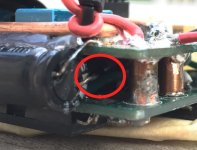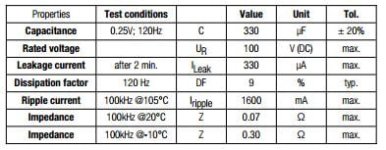to sum up what happened: now after i used another dc/dc converter, it's cap just BLEW UP. got hot within seconds and exploded. so i thought the cap was bad, and replaced it with a new one 100v 10u. this blew again after a few seconds. but this time the FET on the dc/dc converter exploded as well, and the 15v dc/dc onboard converter chip exploded as well.
not looking too good. just replacing both the LTC3638, will just lead to another exploded chip.
so i was in discussion with lebowski, and he said that normally the 3 big caps (100v120u) should take care of that. i mentioned that there was no spark when i connect the battery, but this was not new, as i always used a. inrush limiter - just for bench testing it used a direct attached battery.
so i took a look at the caps and measured continuity to the board. they are attached to GND and VCC of course. but ALL 3 wires to GND where just MOLTEN. you can see it on the picture. HOW CAN THAT HAPPEN????
you can clearly see that they are molten, as the wire is thicker where it melted.
i can repair that, but w/o knowing the cause i guess this will happen again.
at least i now found the reason why the dc/dcs broke all the time.
here is a picture. exposure while taken was very high so you can see the dark part.




